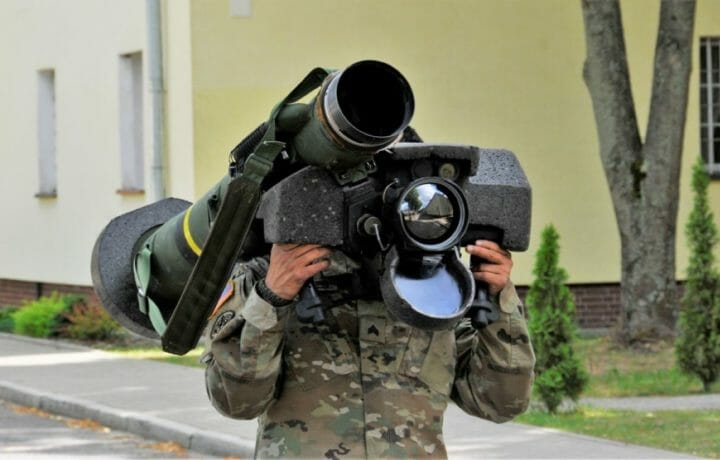During the First World War, the British Army faced a shortage of artillery shells on the front lines that was so great it led to a political crisis that resulted in the fall of Prime Minister H.H. Asquith. The government even enacted the Munitions of War Act 1915, which was meant to maximize munitions output, while it also brought private companies supplying the British military under tight control of the newly created Ministry of Munitions.
Though the United States isn’t facing a similar crisis, there is a concern that Washington’s supply of ordnance – notably FGM-148 Javelin anti-tank missiles and Guided Multiple Launch Rocket System (GMLRS) surface-to-surface missiles – supplied to Ukraine has depleted the Pentagon’s stockpile.
Earlier this month, Bradley Bowman, the senior director of the Center on Military and Political Power at the Foundation for the Defense of Democracies, a Washington-based nonpartisan think tank, warned that maintaining ample levels of the GMLRS should be a key concern for the U.S. military.
“I really think we’re confronting a U.S. munition production capacity crisis because for too long we procured things at the minimum rate, just to keep production lines going ― and now we’re paying the piper,” Bowman told DefenseNews “Surge capacity is not there, and we need to be procuring enough to arm our own forces and ensure their readiness while providing Ukraine and Taiwan with what they need.”
American Stockpiles Used by Ukraine
It could be argued that the United States military isn’t actually fighting a war, yet its supply of ordnance is being used as if it is engaged in combat.
“That is a fair representation,” said Col. Mark Cancian, USMCR (Retired), senior advisor with the Center for Strategic & International Studies. “This is giving us a sense of the demands of a modern war. It isn’t actually a revelation, but it highlights how quickly the stockpiles can be depleted.”
At issue is that the defense contractors that produce such ordnance are quite efficient in what they produce and how they produce it.
“One thing about production is that they respond to the demand signal,” Cancian told ClearanceJobs. “If we are asking for 1,000 Javelins a year, then the industry will facilitate the production according. If you can built 5,000 units a year at a facility that is wasteful if the order is for 1,000. Industry must respond to the number that is required to be efficient.”
Cancian further explained it might even be wrong to call this current situation a “crisis,” as the United States military planners have supplied Ukraine with what they believe to be acceptable. Though there is risk, the U.S. continues to maintain ample supplies.
In fact, much of the ordnance sent to Ukraine was what the U.S. military likely had stockpiled for a potential war against Russia. Thus, it could be argued it is being used in such a conflict, albeit one the U.S. fortunately isn’t fighting. Some critics have warned that the U.S. stockpiles are dangerously low, should the military be forced to confront China, but that would likely be a far different type of war.
“The weapons that were sent to Ukraine are for a ground campaign,” Cancian continued. “A war with China would be air and naval. The ground war that the U.S. could face would be in Korea. However, military planners have given what they are comfortable with, and they have accepted some risk – and are now working to replace the ordnance.”
The Issue is Time
Efforts are now underway to replenish America’s stockpile – something that has the support of Congress. However, it is simply going to take some time. Even with surge production, it is likely it could be years before the Javelin stockpiles are at the old levels.
It is worth noting that the weapons aren’t exactly going to waste – apart from the notion that all wars are wasteful. In fact, while most artillery shells and small arms ammunition have a very long shelf life of decades, some of the more advanced hardware has a much shorter shelf life. The Javelin may not be stamped with a “best used by,” but that is certainly the case.
“For the Javelin and similar systems, it is about 15 years or so,” said Cancian. “The military regularly does batch testing of old ordnance, and 70 percent is the accepted reliability rate. Once the lot diminishes past that point it is no good, and you get rid of it. Most munitions aren’t actually used, and they sit in shortage for around 15 years and then are demilled or destroyed!”
Ukraine Can Expect Substitutions
As the U.S. must rebuild its stockpiles, Kyiv may likely have to accept a lot of substitutions – or different weapons. It is hardly alone. Russia has lost so many modern T-72 and T-90 main battle tanks (MBTs) since it launched its unprovoked invasion eight months ago that it is has had to take Cold War-era T-62 tanks out of storage to fill the ranks.
The situation is far less dire or extreme for Ukraine’s fighters.
“The U.S. isn’t sending anymore 155mm howitzers and rounds as we are depleted what we can send, so we’re sending retired 105mm howitzers and rounds,” Cancian told ClearanceJobs. “We’re not sending Javelins, and instead are sending TOW rockets. There is some truth that Kyiv won’t get the top of the line, but those are still very good weapons that just aren’t used by the U.S. The Ukrainians won’t go without, and neither will the U.S. military.”
There is now some truth to the old expression, use it or lose it!




